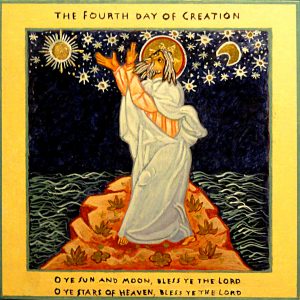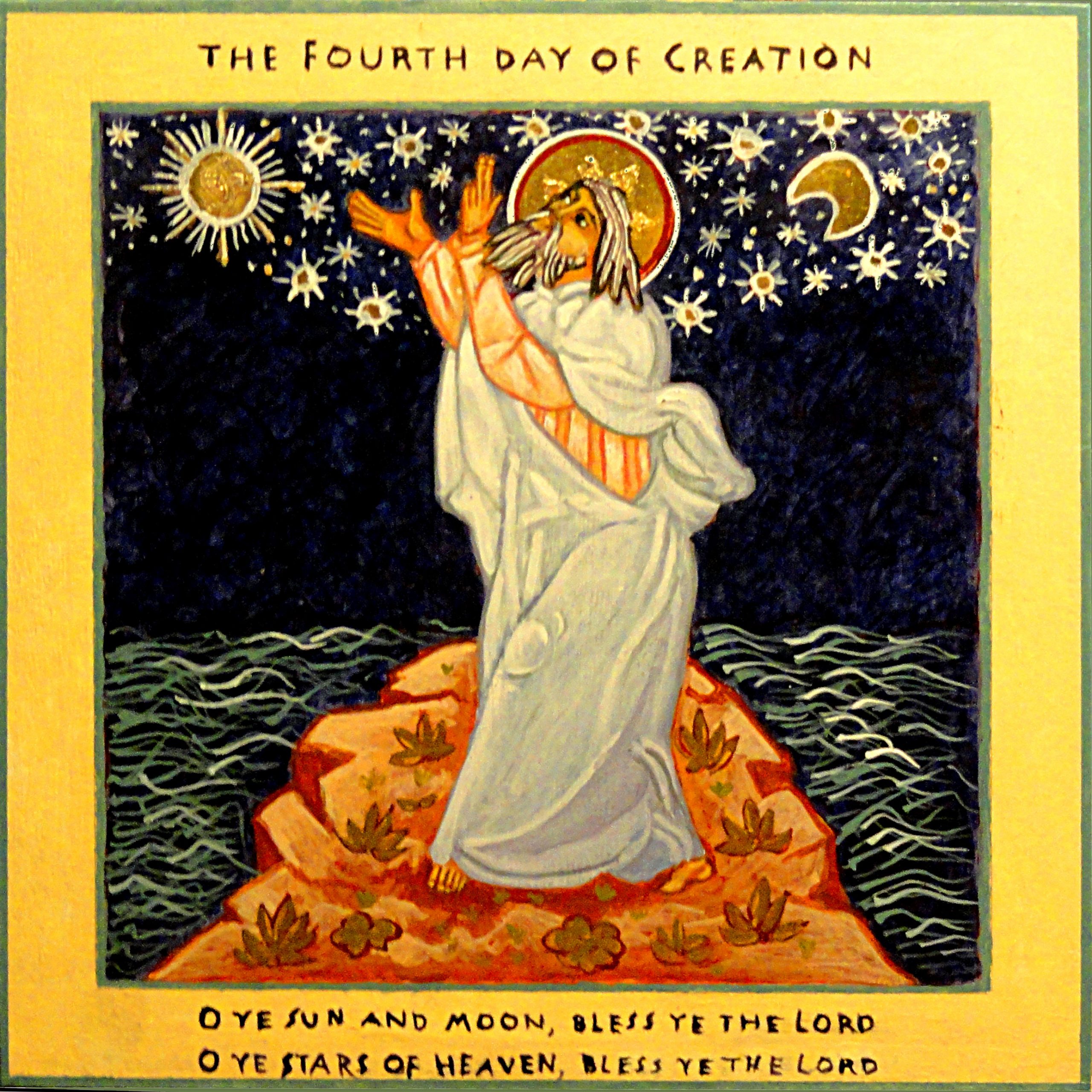. . . learning about icons

The Fourth Day of Creation based on a 16th century German Woodcut. This is not really an icon.
The painting at the top of the page represents the Fourth Day of Creation. The man in the picture, called the "Ancient of Days" is technically not God the Father but a stand-in, since images of God were not allowed. You can find a little more about it on Betsy Porter's site.
Nevertheless, I have a specially kind feeling towards this little work. The Ancient of Days is so delighted in the Sun and Moon and Stars and he's such an elegant guide. It also reminded me of my favorite canticle that I painted some of the words on the bottom of the frame.This was the third icon I painted, but the first after I got home from a week-long icon-painting workshop. Technically, it is not an icon. The drawing came from a German woodblock. I learned all of this on Betsy Porter’s site.I find the history of icons somewhat murky. There is a story that attributes the first icon to St. Luke and there are many icons showing Luke painting a portrait of Mary with the baby Jesus which tradition says is the first icon. To me, absent documentation, these stories are a matter of faith. When it comes to evidence, the catacombs where burials occurred show some spontaneous drawings commemorating the mourned buried there.
This was the third icon I painted, but the first after I got home from a week-long icon-painting workshop. Technically, it is not an icon. The drawing came from a German woodblock. I learned all of this on Betsy Porter’s site.
I find the history of icons somewhat murky. There is a story that attributes the first icon to St. Luke and there are many icons showing Luke painting a portrait of Mary with the baby Jesus which tradition says is the first icon. To me, absent documentation, these stories are a matter of faith. When it comes to evidence, the catacombs where burials occurred show some spontaneous drawings commemorating the mourned buried there.
Drawings inspired by the story of Jesus appear for Christians buried there. The quality of the drawings vary. Some are quite primitive. Others are quite skillful. Estimates of the time of the drawings range from 1st to 2nd century CE. But it isn’t until the third century, after Emperor Constantine accepted Christianity and became the secular head of the faith that the importance of icons in worship became accepted (somewhat).
For some centuries the icon workshops operated under the supervision of the Emperor. As the production of icons became formalized, the mixed feelings of the clergy and the faithful began to appear, climaxing in two periods of iconoclasm in the 8th century, when the veneration of images was forbidden. It was finally and permanently reversed after the second round of iconoclasm.
While in the early centuries, icons were used in worship throughout Christianity, the Western interest declined after the split of the church permanently into the Eastern Orthodox Church and the Roman Catholic Church. I don’t honestly know when the Western church started noticing and appreciating Eastern Iconographpy again. For me, it happened because I married a Greek. My mother-in-law’s apartment was filled with icons that had been handed down through generations.
I found most of the icons interesting, but not attractive. Jesus and the Saints looked very angry. My husband informed me that the expression was not meant to be considered angry, but serious and thoughtful – a sign of wisdom. This “serious and thoughtful” consideration was also represented by either a book or scroll in one hand of the subject of the icon portrait.
An aside:- among the many standard icons in my m-i-l’s apartment were two locally crafted icons (locally, being the Ionian Islands) of which my favorite was a representation of the Bishop-Martyrs of Corfu, Kalaphonya, and Zakynthos in the throes of their martyrdom. It sounds grotesque but you only saw their mitered heads and their feet. There was a sheet of silver covering most of the icon, so you saw nothing else. It was about 5″ x 6″, very small.
After my m-i-l died, we looked into taking some of the icons to the U.S. with us. Greece has a law which says that you cannot remove icons a hundred years or older without approval from the Antiquities Department. We inquired informally from an antique dealer. All those old grouchy saints – we could probably take them. The two Ionian icons – nope, the island icons were prized. So they remain in Greece. So do the wise ones.
I didn’t plan to write so much background stuff. Check out the historic information. I was just writing from memory. Some people might not like my less than idealistic point of view. Despite history supposing to be factual, there are many instances of faulty memories. More in part 2.

